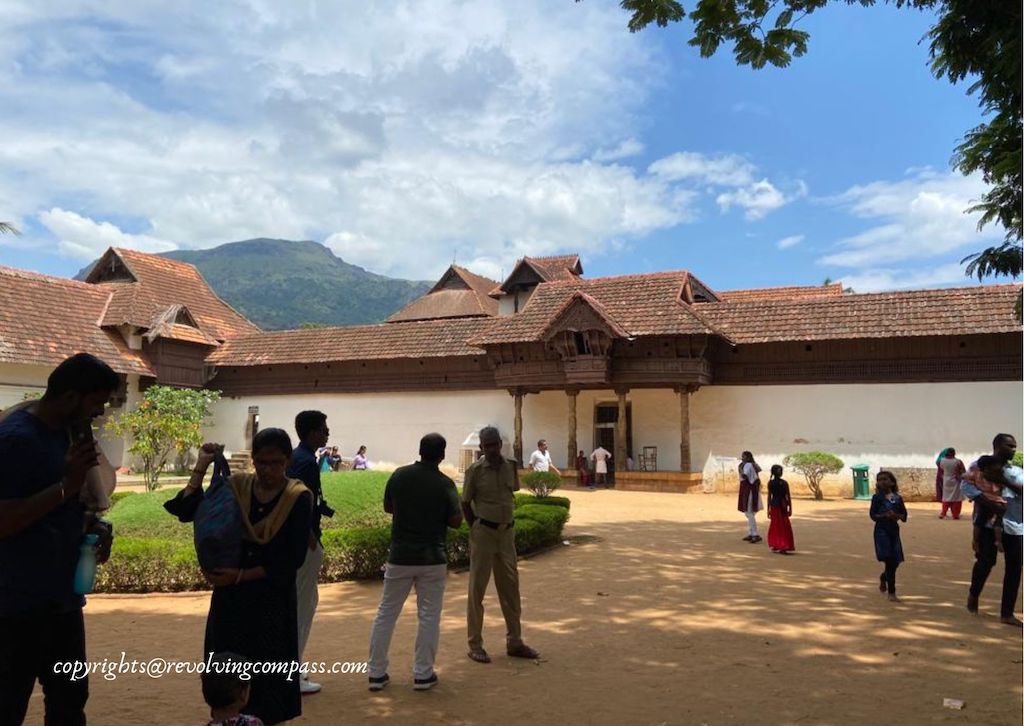On our recent road trip across Kerala, while traveling from Trivandrum to Kanyakumari, I stumbled upon a palace like none other I have seen earlier – the Padmanabhapuram Palace of the earstwhile Travencore Kingdom of Kerala. Although, it looked so much simpler than the other forts and palaces I have visited like the Amer Fort, Udaipur Palace, Jaisalmer Fort or the Mehrangarh Fort of Jodhpur. On the surface, it does look very simple. But as you start to explore, you see the beauty of the Padmanabhapuram Palace unfold. It is a one of a kind palace, very strategically designed and very intricately carved. Let me take you on a journey through this palace with me today.
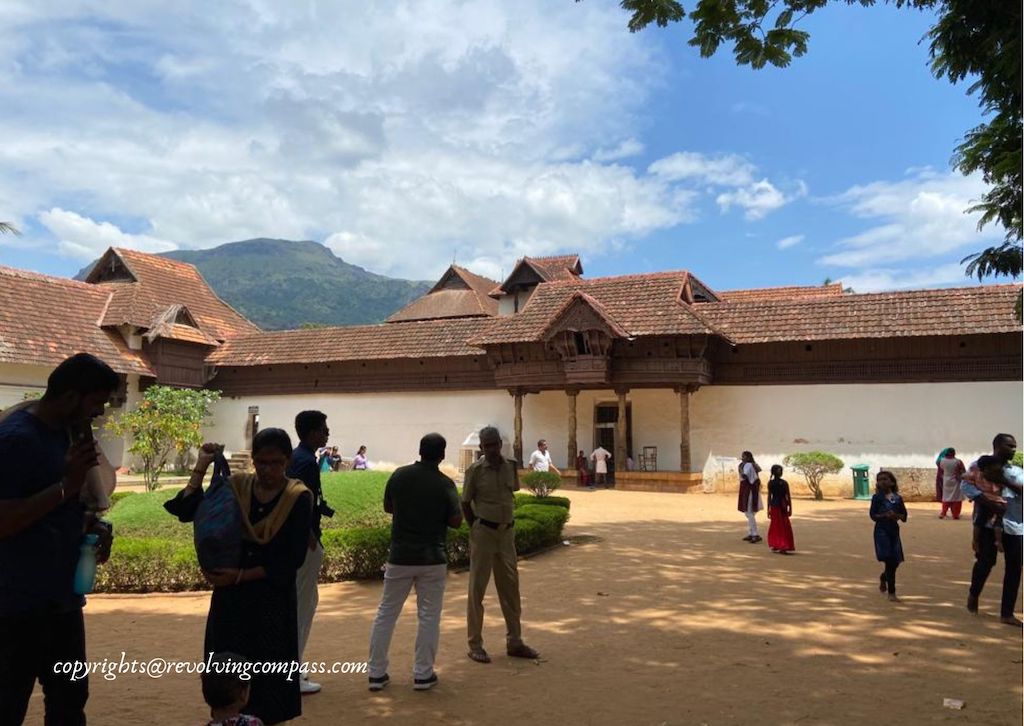
Padmanabhapuram Palace history
The Padmanabhapuram Palace was built by Iravi Varma Kulasekhara Perumal in around 1601 AD. At that time, it was called Darpakulangara Koikkal and Valiya Neerazhikkara Koyikkal. Later it was rebuilt in around 1750 AD by King Anizham Thirunal Marthanda Varma. The family deity of the Travancore Kingdom was Padmanabha – an avatar of Lord Vishnu. Since the Palace was dedicated to the deity, hence it’s name “Padmanbhapuram Palace”. Interestingly, in the mordern day the Padmanabapuram Palace lies in the borders of Tamil Nadu. But, since it was a part of the Travencore Kingdom, it is still maintained by the Kerala government. Actually, the Padmanabhapuram palace is maintained by the Govt. of Kerala Archaeology Department.
The place where the palace stands today was earlier a village called “Kalkulam”. And it was initially ruled by the powerful Venad Kingdom which later became the princely state of Travencore. Padmanabhapuram Palace, along with the palaces of Thiruvithamcode, Keralapuram, and Eraniel, was known as ‘Pada Veedu’, and together, these palaces were part of a massive fort. Strategically located in the foothills of the western ghats. But unfortunately, most of the other palaces of the region are in ruins now, with only Padmanabhapuram Palace still withstanding the test of time.

After the British attack on the region, the subsequent rulers of Travencore Empire shifted base to modern day Trivandrum or Thiruvananthapuram – the capital of Kerala. There, they constructed a fort with the Padmanabhaswamy Temple in the center of the fort. With this move, the Padmanabhapuram Palace lost it’s glory. A manager looked after the palace thereafter. And till the 19th Century, the Navratri Festival was celebrated from the Padmanabhaswamy Temple. Thus, keeping the connection of the Travencore kingdom to the Padmanabhapuram Palace alive.
Padmanabhapuram Palace secrets
The Padmanabhapuram Palace has a secret passageway just like several other forts and palaces of India. This secret passageway connects to another palace miles apart. When the fort was under attack, the king and his family used this secret passageway to escape from the Padmanabhapuram Palace. This passageway remains closed now and is not accessible to tourists.
After the Royal family shifted base to Trivandrum, the palace remained closed for most of the year. Apart from the Navrathri Celebration that was held here. Also, the public had no access to the palace. So, they started to believe that the Padmanabhapuram Palace was “haunted” ! And the rumors continued till the 20th century, when it was reopened to public for viewing and became a major tourist attraction of the region.
Not just that, there is secret element even in the construction of this palace! The palace floor was made with lime and mortar mixed with certain herbs. That gave the entire floor a mirror like shine!
A Virtual Walk through the Padmanabhapuram Palace Kerala
The heavy woodwork, the structure of the roof and the overall look of the Padmanhapuram Palace strongly reminded me of the Bangkok Palace that we visited on our 5 days trip to Bangkok. Actually, I should put these two in this writeup : locations and architectures in India that resemble foreign places. But after reading and researching more about it, I came to know that the Padmanabhapuram Palace is the largest wooden palace in whole of Asia! The complete palace is built at over 6.5 acres of land. And every nook and corner of the palace exhibits intricate woodwork.
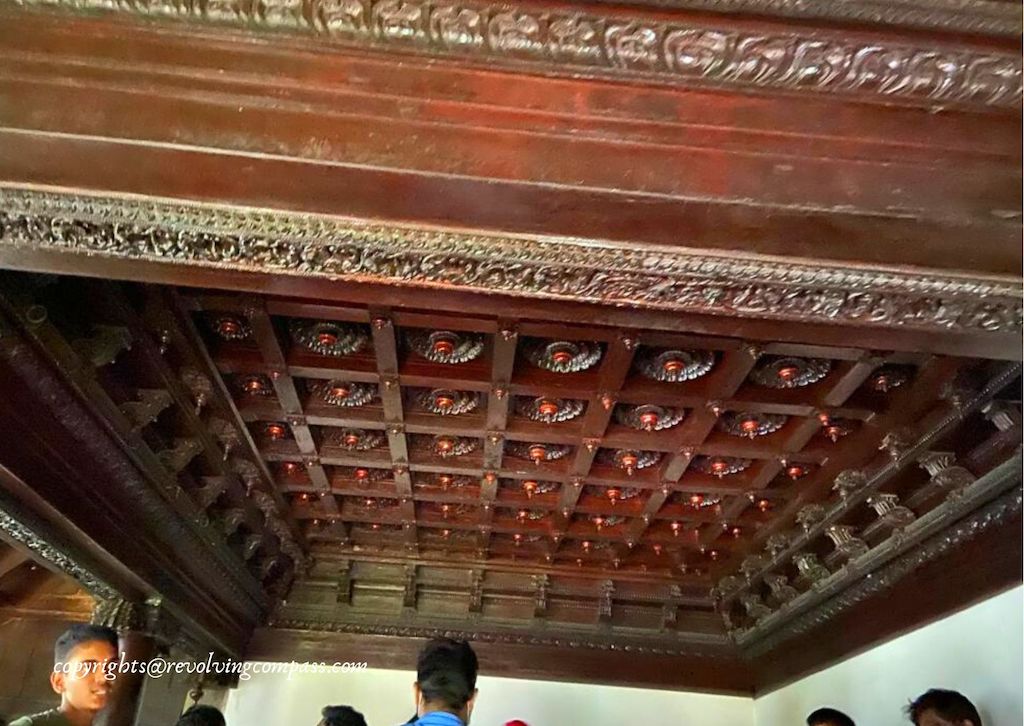

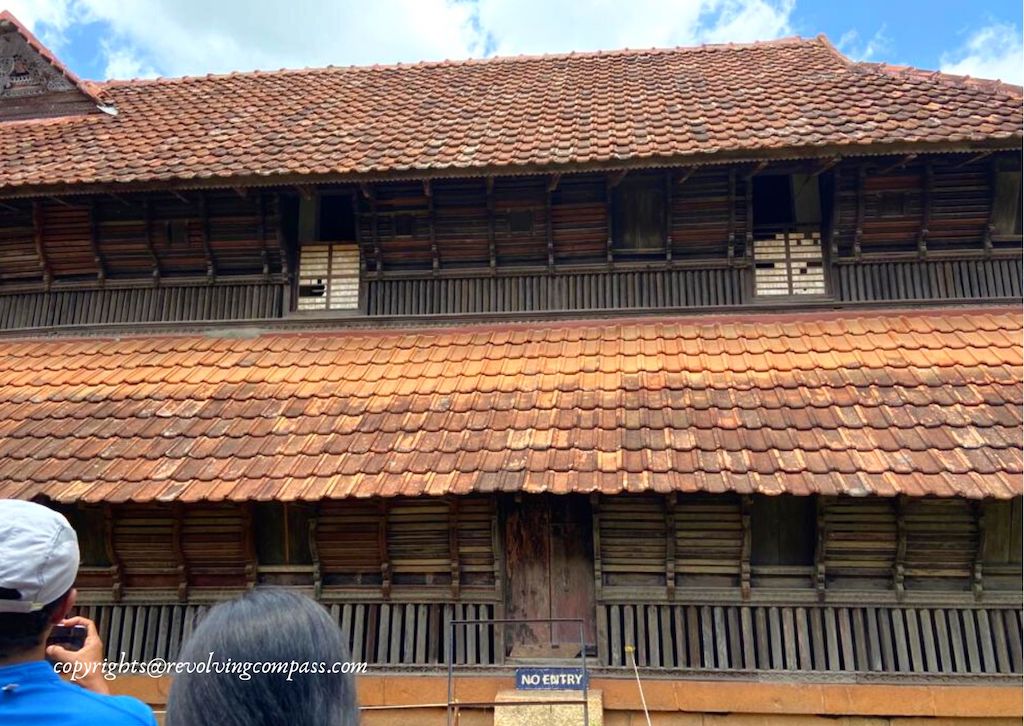
The entrance & courtyard of Padmanabhapuram Palace Kerala
A robust fortified wall runs all around the Padmanabhapuram Palace. The “mukhya vāthil” or main gate is located towards the west from where one can enter into the palace complex. This is the gate we entered from. Towards the left of the gate is the ticket counter. And towards the right, the place to deposit shoes, a museum and “pay and use” toilets. Once you deposit your shoes on the right side, you can go to the left side and purchase the tickets from there. Stones quarried from nearby areas were used to build the foundation of the palace. Whereas the floor is made of mortar and lime. While most of the upper pillars, roof and other structures are made of timber. Heavy use of timber with interspaced planks lead to air conditioning like effect. Thus, providing much needed respite in the hot and humid climate of Kerala.
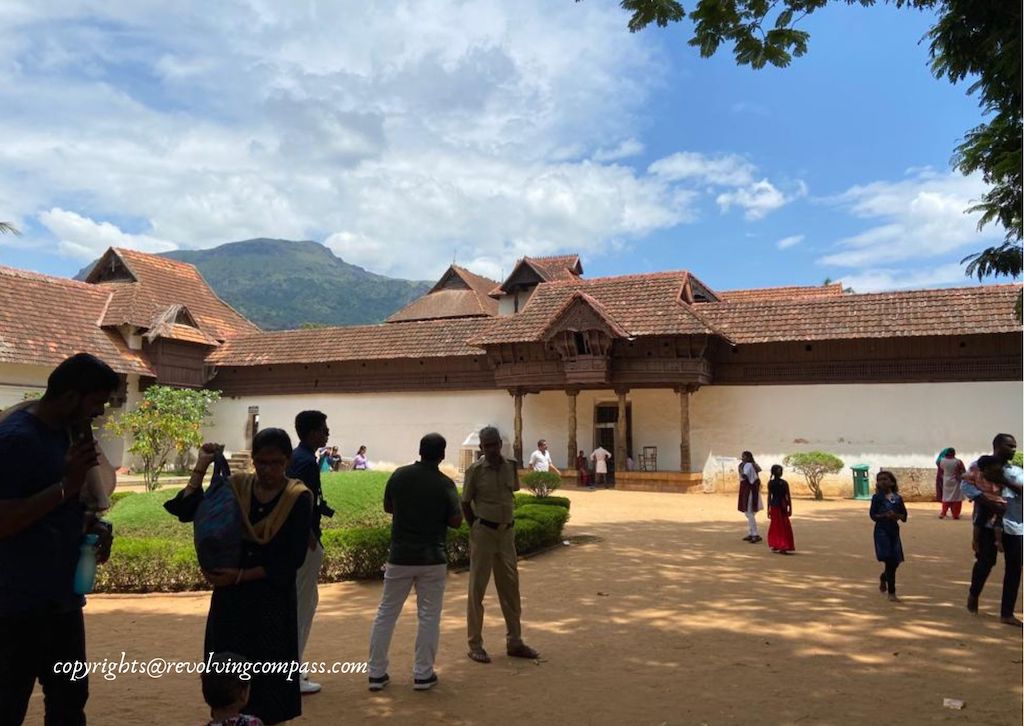

Old Clock & Clock Tower
As you stand in the central courtyard, you will be able to see a tall clock tower inside the Palace complex. The clock on this clock tower is more than 300 years old and still perfectly operational!

The large hall
As you enter in the main palace complex from a second door, towards the left lies a huge hall. Currently very less of the internal intricate architecture is remaining. But once upon a time, this huge hall was used as a “convention hall” for holding parties and meetings. It has a capacity of hosting more than 1000 people together! At the end of the hall are kept the huge vessels and utensils used inside the palace.
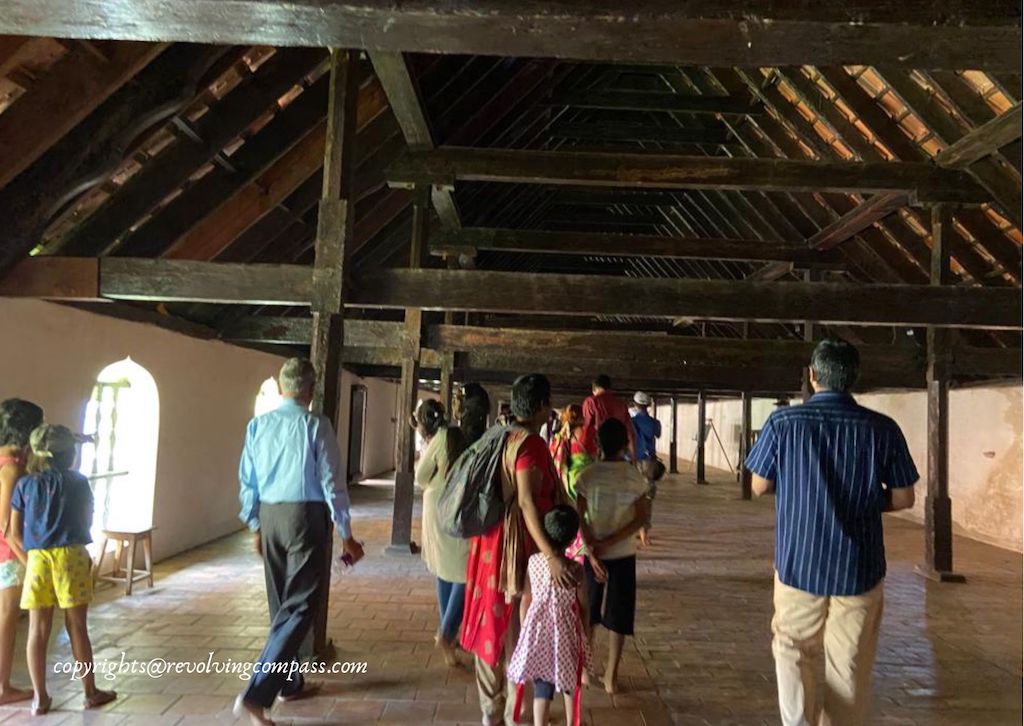

Internal courtyards and different chambers
From the hall, as you enter inside, there are several internal courtyards and chambers that you can pass through one after the other like entering inside the layers of an onion 🙂 . An areal view of the Padmanabhapuram Palace shows that the courtyards and interspersed chambers were strategically made to delay enemy attack. And they were interconnect with one another through more than one covered corridors and secret walkways at times, that only those living inside the palace were well versed with.


Passing through several such chambers, I arrived at the “entertainment hall”. A small hall with beautifully and intricately carved pillars with sculptures of ladies and animals. Like the ones you see in the ancient temples of India. It looked like a chamber where dance would be performed, or maybe puja. At the farther end of this courtyard was a temple like construction. Alas, the lady volunteer standing there couldn’t help much. But yes, it did look like a temple.


Moving further ahead, a heavily crafted triangular structure caught my attention. The carvings here were so intricate. Although on wood, it reminded me instantly of the carvings that I saw on stone when visiting the Stupa of Sanchi and the Udayagiri Caves on my MP road trip.

How to reach Padmanabhapuram Palace Kerala
Nearest airport to Padmanabhapuram Palace is Thiruvananthapuram Airport (Formerly Trivandrum Airport). The place has a good connectivity to both Thiruvananthapuram as well as Kanyakumari via road. Which in turn have good connectivity with all the major cities in India via road and rail network. So, one can self drive to Padmanabhapuram Palace. Or, one can take a taxi or a day tour to Padmanabhapuram Palace from Trivandrum or Kanyakumari.
Kanyakumari to Padmanabhapuram Palace distance
The driving duration from Kanyakumari to Padmanabhapuram Palace is just 1 hours. We drove from Thiruvananthapuram to Padmanabhapuram Palace and then to Kanyakumari from Padmanabhapuram Palace. The NH 66 connects Trivandrum (Thiruvananthapuram) to Kanyakumari. And Padmanabhapuram lies almost on the NH itself , with just a 2 km detour inside.
Padmanabhapuram Palace opening time
The Padmanabhapuram Palace is open from 9:00 am to 12:30 pm and then from 2:00 pm to 4:30 pm on all days except for Monday and public holidays.
Padmanabhapuram Palace entry ticket
The entry ticket to Padmanabhapuram Palace is INR 40 per adult and INR 10 per kid more than 5 years of age for Indian nationals.
For foreign nationals, the entry fee is INR 350 per person.
The ticket counter is located on the left side inside the campus. It is open from 9:00am till 12:30pm. And again post lunch from 2:00 pm.

Best time to visit Padmanabhapuram Palace
The best time to visit Padmanabhapuram Palace will be morning hours or evening around 4:00pm. We are required to take our shoes off and deposit at the shoe counter on the right side of the palace. And then walk barefoot on the sand and the stones inside the palace. They tend to get really hot in the day. You will get burning sensation in your legs. Something that I didn’t like. Particularly with kids. If we are supposed to take our shoes off then there should be some arrangement of comfortable walking like carpet etc.
Season wise, the months of October through February are best to visit Padmanabhapuram Palace. Since, although it is still hot and humid but bearable compared to the peak summer season.
Tips on visiting Padmanabhapuram Palace
- Best time to take a Kerala trip is between October to February as it is not unbearably hot at this time of the year.
- Do not hesitate your tour operator to include the Padmanabhapuram Palace in your Kerala Trip Packages as it often gets overlooked.
- Try to reach early in the morning to avoid traffic rush.
- Also, you have to walk barefoot in the premises so early morning hours will be easier when the sand and floor is not that heated.
- Parking can be done on the street leading to the Palace. But it can as well start getting crowded as the day advances.
- It will take 30-50 minutes to explore the whole palace.
- There are pay and use restrooms in the Padmanabhapuram Palace complex. They were relatively clean.
- Snack shops and tender coconut is available in the street leading to the Palace.
More resource related to our Kerala Trips
Encountering one of the most majestic waterfalls of India – Athirapally Waterfalls
Offbeat Places to visit in North Kerala
10 things to do in Kumarakom Kerala
Visiting Munnar, Thekkady and Alleppey in 5 days – the most popular honeymoon triangle of Kerala
A guided tour to spice gardens of Kerala
How to make the most of your time at Alleppey – the venice of India
A complete guide to exploring Wayanad
A 4 days trip exploring Munnar – one of the most beautiful places in India
PS: Some of our links are affiliated, this means we will earn a commission when you buy a service or product by clicking those links. However, this will have no extra cost for you.
